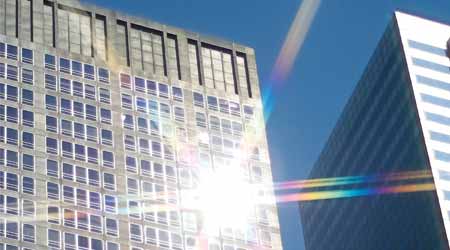 Today’s window films and coatings have been developed to selectively block the sun’s infrared radiation while admitting most of the visible light.
Today’s window films and coatings have been developed to selectively block the sun’s infrared radiation while admitting most of the visible light.High-Efficiency Windows: Effective Strategy For Energy Savings
First part of a three-part article on glazings and other energy efficient windows options.
The installation of high-efficiency windows continues to be an effective strategy for facility managers seeking to improve energy efficiency. Today there are more options than ever before for upgraded windows, giving facility managers the ability to choose the type of window that best matches the needs of their facility. But having so many choices can result in confusion. What features are really needed? Which ones will provide the greatest rate of return for the investment? To answer these and other questions, facility managers first need to understand what options there are and what they will provide in terms of energy performance.
There is no universal replacement when it comes to windows; one size does not fit all. Options today include the number of glazings installed, the use of an inert gas between the glazings, the application of a reflective coating or film to the glazing, the use of a low-e glazing to reduce radiant heat loss, the use of internal or external shading devices, and the type of materials used to construct the window frame.
Not all options provide the same level of benefit for all applications. And in some instances, choosing the wrong option not only unnecessarily increases the cost of the window project, but also may reduce the overall energy effectiveness of the window installation.
Analyzing glazings options
Almost all windows installed in new construction or renovations today have either two or three layers of glazing. Of these, the majority use a two glazing construction. The effectiveness of a material to resist conduction of heat is its U-value. The lower a material’s U-value, the better its insulating properties. Dual-glazed windows with no coatings have a typical U-value of approximately .48. Triple-glazed windows of the same construction, also with no coatings, have a typical U-value of .31, meaning that the conduction of heat through a triple-glazed window is approximately 35 percent less.
The question is whether the increased cost of a triple-glazed window is worth its additional cost. In general, the energy savings from triple-glazed windows justify the increased installation cost in cold climates where heating costs significantly exceed air conditioning costs. In mixed climates where heating and air conditioning costs are of the same order of magnitude, triple-glazed windows will reduce heating costs but the reduction may not be sufficient to justify the additional cost. In southern climates where air conditioning costs exceed those from heating, savings from triple-glazed windows typically do not justify the higher price.
There is a significant exception to these rules of thumb. In warm climates, condensation on the window exterior during periods of high humidity may result in the formation of condensation on the window exterior, blocking views both into and out of the building. In certain applications, such as those involving security areas where visibility is a critical factor, triple-glazed windows may offer reduced levels of condensation.
Gas-filled glazings
The space between the glazings in dual- and triple-glazed windows has traditionally been filled with air. When there is a temperature difference between the outer layers of the two glazings, the air between them moves as a result of convection, transferring heat from one surface to the other. The rate of convection depends on the temperature difference between the glazings and the distance between the glazings, typically one-half inch. The greater the rate of convection, the higher the heat loss or heat gain through the window.
The rate of convection can be reduced by replacing the air with an inert gas such as argon or krypton. Both are slower moving, more viscous gases. Argon, being the lower cost gas, is more widely used in windows with the standard separation between glazings of one-half inch even though the thermal properties of krypton are better. In special applications where the separation between glazings is less than one-half inch, krypton may be used to improve performance. Gas-filled windows are most often built with a low-emissivity coating on one of the glazings.
Over time, it can be expected that some of the gas will leak out of the window. High-quality, well-constructed units have been found to lose about ten percent of their gas volume over a 20-year period. This loss, however, only results in a few percentage point increase in the window’s U-value.
The impact of gas filling alters the overall U-value of the window. For example, a triple-glazed window with air between the glazings has a typical U-value of .31. When filled with argon, the U-value decreases to .26, and when krypton is used, to around .23. All three values are for the window with the standard one-half inch gap between glazings. Again, any decrease in U-value indicates an increase in energy efficiency.
Windows filled with an inert gas rather than air do cost more. And while they reduce energy losses through the windows in any application, their use is typically limited to those in northern climates where the cost of heating is high.
Related Topics:










